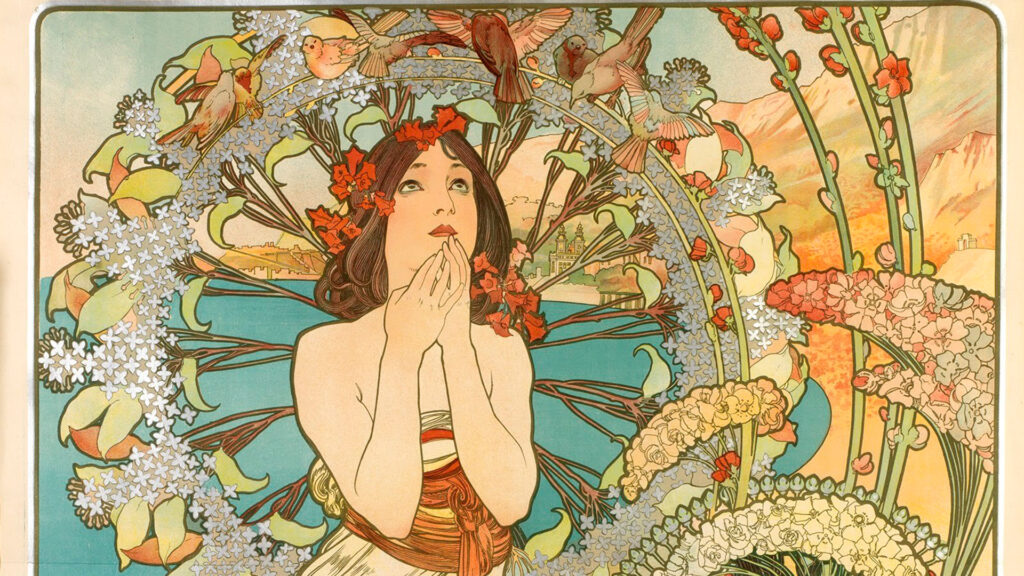Periods in art history are susceptible to cycles and changes, just like fashion, music, language, and general aesthetics in everyday life. Art Nouveau is one of the most well-known artistic and fashion movements of the 20th century, which falls within the broad category of Modern Art.
From roughly 1890 to 1910, the Belle Epoque period, the Art Nouveau style was all the rage. It was the era of art that came before modernism. The Art Nouveau design movement began in Belgium and quickly traveled to America through Europe and the Atlantic Ocean. However, it genuinely spread around the globe.
About Art Nouveau

The word “Art Nouveau” was initially used to characterize the work of Les Vingt, a group of twenty painters and sculptors who sought social change via their artistic endeavors in the 1880s in the Belgian periodical L’ArtL’Art Moderne. The “Maison de l’Artl’Art Nouveau” (“House of the New Art”), a Parisian art gallery that first opened its doors in 1895, is credited for popularizing the phrase.
The Aestheticism of artist Aubrey Beardsley, who highlighted the expressive nature of the natural line, and the Arts and Crafts movement of William Morris, who emphasized the significance of a lively floral style in the applied arts, was the final trailblazers of the style in England. Finally, Paul Gauguin and Henri de Toulouse-expérimentation Lautrec’sLautrec’s expressive lines impacted Art Nouveau on the European continent.
Art Nouveau was a reaction against the harsh living conditions and lifeless, mass-produced goods of the industrial revolution and the strict historical art era, which dominated art education from the 17th to the 19th century. Many amazing Alphonse Mucha drawings are based on this style.
About Alphonse Mucha

One of the most influential names in the Art Nouveau movement was the Czech painter, graphic designer, illustrator, amateur photographer, and artisan Alphonse Mucha. In Paris, Art Nouveau was sometimes referred to as “Le Style Mucha.”
The illustrator depicted stunning women posing against floral landscapes using a palette of subdued pastels. His use of sensuous natural shapes praised Art Nouveau’s ideals. Alfons Maria Mucha was born on July 24, 1860, in what is now Ivanice, Czech Republic. His youth was influenced by his Catholic upbringing, his love of music, and his creative abilities. Mucha learned how to do art on his own.
After finishing his study and spending a brief period (1885–1887) in Munich at the Academy of Fine Arts for educational purposes, Mucha made the audacious choice to move to Paris in 1888. Mucha switched his attention from painting to magazine illustration while he was a resident in Paris.
The Industrial Revolution advanced, and printing methods improved. Paris’sParis’s streets were lined with posters by the early 19th century. The medium became well-liked and respected and was used to make money.
Mucha’s move from Art Nouveau
Mucha instantly became well-known as a designer due to the extraordinary popularity of the Bernhardt posters, which led to contracts for commercial posters. In addition to JOB cigarette papers, Lefèvre-Utile cookies, Nestlé infant food, Idéal Chocolate, Beers of the Meuse, Moet-Chandon champagne, Trappistine whiskey, Waverly bicycles, and Perfect bicycles, he also created posters for these brands and others. These amazing Alphonse Mucha drawings are a true masterpiece.
One of the pinnacles of Art Nouveau poster art is frequently considered the 1896 poster Mucha created for Sarah Bernhardt’sBernhardt’s performance as Lady of the Camellias. The 134 color lithographs Mucha created in 1897 for Robert de Flers’ French fairy tale Ilsée, Princesse de Tripoli, are among his most significant illustrations. It’s one of the most significant examples of a book illustration from the Art Nouveau period.
Mucha then broke away from Art Nouveau and produced the Slavic Epic, a cycle of 20 enormous canvases that chronicles the history of the Slavic peoples between 1911 and 1928.
Art lovers today learn about Alphonse Mucha sketches to better understand his tremendous skills.
The Lithography of Mucha
Due to the blending of mass industry and great art, the Art Nouveau floral themes swiftly became a significant element of daily life. Many Alphonse Mucha sketches employed lithography as the printing method. Like The Four Seasons, some of his posters were created as complete sets.
Sarah Bernhardt’s Contribution

In December 1894, when famed actress Sarah Bernhardt was at the height of her career and seeking an artist to create a new poster for the play of Gismonda in which she was appearing, Mucha, who was struggling financially, eventually got his big break.
The managing director Maurice de Brunhoff last-minutely hired the ardent theater enthusiast Mucha to create the campaign, which the artist executed as an enormous billboard with romantic themes, swirling silhouettes, and mosaic patterns. Alfons Mucha became a well-known artist due to the artwork shown all around Paris, and he signed a long-term deal with Bernhardt.
Bernhardt was shown wearing the garb of Byzantine noblewoman, carrying a palm branch with an orchid headpiece and flowery stole.
The elaborate rainbow-shaped arch behind her head, which resembled a halo and highlighted her face, was one of the posters’ novel design elements. All of his ensuing theater posters included this characteristic.
The Byzantine mosaic tiles behind her head were the sole backdrop adornment. Unlike the customary bright-colored posters of the day, the poster had outstanding artistry and delicate pastel tones. The title and decorations at the top of the poster balanced out the bottom, with the theater’s name as the only pertinent information. They were presented in the slightest possible manner.
Conclusion
Mucha’sMucha’s legacy survives until today. The Art Nouveau form language is brought into the present by the modern award-winning artist Echo Chernik, inspired by its undulating lines. Mucha’sMucha’s legacy and the Art Nouveau movement’s impact opened the path for commercial graphic design and artistry to be raised to the status of a replicable art form.





